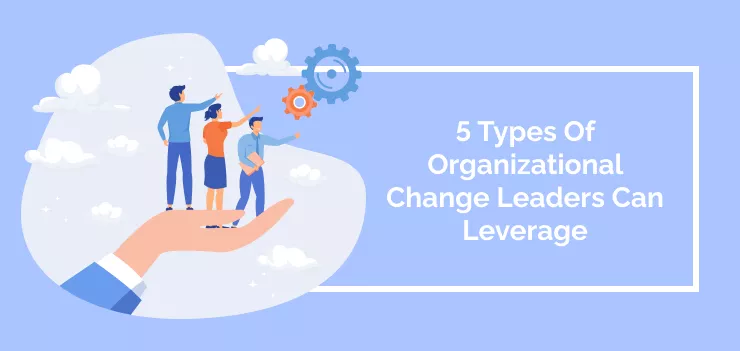
As businesses become more global and technology-driven, companies must be able to respond to rapid change. To do this, organizations must understand the power of organizational change and its potential for driving progress.
However, the difficulty of enacting effective change management on behalf of business leaders can sometimes emerge as an unfortunate obstacle to successful change. This can be because the right plan has yet to be implemented, or the areas needing organizational change have yet to be identified.
Gartner states that the average organization has undergone five significant business changes in the last three years – nearly three-quarters anticipate undertaking even more major change initiatives over the next three.
Many factors necessitate organizational change, such as responding to current market trends, introducing new technologies, improving customer service, increasing profits, or accelerating executive velocity. Successful organizational change increases efficiency, employee morale, and more substantial business.
Whatever it may be, before implementing change across the organization, business leaders must identify all areas that require transformation, along with practical solutions that dampen any disruptions during the transition. In this regard, identifying and carefully considering the types of organizational change is critical for achieving optimal outcomes.
In this article, we’ll explore the six types of organizational change and provide insights that help leaders determine when to use one type over another. We’ll also examine the current state of organizational change processes in 2023, complete with key tips for implementing effective change.
What is organizational change?
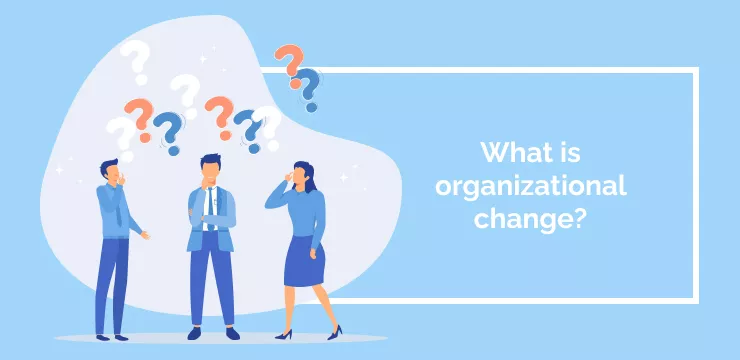
Organizational change is modifying current structures, procedures, and practices to gain a competitive edge, increase efficiency, and drive business results. It involves analyzing the organization’s environment, defining clear objectives, and making systematic adjustments to achieve them better. This might include restructuring departments or teams, altering job roles, introducing new systems and processes, or retraining staff on different procedures.
These changes are carefully planned to ensure success and can positively and negatively impact employees depending on how well they are implemented. The ultimate goal is for organizations to adapt quickly and efficiently as needed.
What value can organizational change deliver?
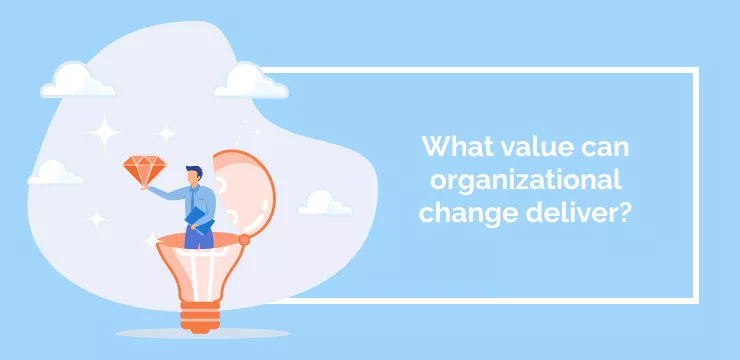
Organizational change can generate exponential value for organizations. Changes can heighten efficiency, enhance collaboration, and create new growth opportunities in the short term. Change also brings improved organizational resilience, enabling organizations to be better equipped to manage change in the future.
In 2023, organizations will be making significant strides in transitioning from conventional hierarchical structures and replacing them with a more flexible and collaborative environment. Forrester’s 2021 report on orchestrating organizational change states, “New technology creates adoption curves, and these curves regulate the pace of an organization generating future value.
This means that organizations must invest in developing processes that foster open communication between all levels of staff and management. This includes building relationships beyond the workplace, such as through social activities or team-building events, to create an atmosphere of trust between all employees.
Successful organizational change also requires top-down executive leadership and bottom-up participation from all staff members. Managers must ensure that employees are rewarded for their efforts and have access to adequate support during transitions so that their contributions will be recognized across teams.
Organizations must also embrace technology as an integral part of transformation initiatives by investing in platforms that enable knowledge sharing and provide insights into customer behavior. This creates an organizational culture where everyone feels supported and engaged while giving employees the tools to stay on top of their work.
The 6 Types of Organizational Change

We’ve uncovered the six most important types of organizational change that your business should be aware of:
- Organization-wide change
- Transformational change
- Personnel change
- Unplanned change
- Remedial change
- Technological change
Organization-Wide Change
Organization-wide change involves adjusting every aspect of a company, such as its structure, processes, culture, and operations. It is generally done to optimize a business by redesigning it to make it more efficient, profitable, and successful.
This type of change may include introducing new departments, restructuring existing ones, changing leadership roles, or developing new processes for better efficiency. It can also involve revising team communication channels, improving customer service methods, and investing in employee development programs.
All these changes should be consistent with an organization’s core values and goals to ensure success.
Transformational Change
Being mindful of the ever-evolving landscape businesses operate within is a prerequisite for success. This involves understanding cultural tendencies, gauging social nuances, and capitalizing on technological developments. As such, transformational change may be required.
Transformational change is a type of organizational change that focuses on an organization’s long-term objectives and strategies. It involves a major overhaul of an organization’s structure, processes, culture, systems, and policies to make them more effective.
Transformational changes include significant reorganizations, cultural, domain, process, digital transformations, etc. Other changes might stem from exploring alliances with other organizations or offering new services that customers want or need.
Implementing this kind of radical change often requires input from all levels of an organization, including a rethinking of external attitudes towards them and internal alignment on objectives and strategies. Though it can be challenging to implement, transformational change is often necessary for an organization to remain viable in the long term.
Personnel Change
Personnel change is any situation where individuals are added to or removed from an organization’s team. This includes hiring new employees, firing staff members, or reorganizing job roles within an organization.
These changes can significantly impact how businesses operate and reach their goals. Personnel changes can also affect staff morale, motivation, and company performance. It is important to continually assess and evaluate your personnel structure as the needs of your business evolve.
When making changes with the people in your organization, it is important to consider how it will affect your business and the people involved. Ensure you are fair to everyone and talk to them about the changes to give them time to adjust. If needed, help them learn new skills and ensure you do not hurt your business by making these changes.
Organizations must ensure that personnel changes do not hurt their bottom line and that affected staff members are treated fairly.
Unplanned Change
Unplanned change occurs when external influences such as economic conditions, geopolitical events, or even natural disasters cause sudden adjustments that organizations cannot control.
Organizations must be able to react quickly and effectively and come up with solutions to minimize disruption caused by these events without sacrificing their bottom line.
In some cases, organizations may even decide to take advantage of certain unplanned changes by capitalizing on their opportunities.
Unplanned organizational change can be disruptive and difficult to manage. To help ensure a successful transition, organizations should consider the following strategies for implementing sudden unanticipated change:
- Develop a crisis response plan in advance
- Create communication channels
- Involve stakeholders
- Address employees’ concerns
- Monitor progress
Remedial Change
Remedial change occurs when an organization realizes that certain strategies or tactics are ineffective due to external changes such as market shifts or technological advancements. It requires existing measures to be reversed to establish new approaches to better align with the current business environment and customer demands.
To ensure successful results while minimizing costs, organizations must monitor progress during remedial change implementation; otherwise, they risk further disrupting their operations if the adjustments made fail to deliver value.
Companies might consider using analytics and metrics to measure the impact of their efforts to identify any areas needing improvement, as well as employing process optimization techniques for those processes that require frequent changes.
It is important for companies engaged in remedial change initiatives to evaluate potential risks associated with the transformation and develop mitigation plans accordingly. This includes anticipating potential roadblocks and developing contingency plans if something unexpected happens.
It is also essential for company leaders to actively engage all stakeholders within their organization, including employees, suppliers, partners, and customers, so everyone knows what’s going on throughout the transformation journey.
Generally speaking, applying remedial change within an organization requires foresight and active involvement from top management at all stages of implementation – from initial strategy formulation through execution – to ensure the timely delivery of intended outcomes without compromising quality standards or overall objectives.
Technological Change
Technological change is the adoption of new technology by organizations to improve their operations and gain a competitive edge in their respective industries. It involves replacing existing technologies with more efficient and reliable ones, thus enabling companies to better optimize processes for increased productivity and cost savings.
Companies should carefully assess the current capabilities of their employees before investing in new technologies. To ensure successful implementation, organizations need to provide adequate training and support to those affected by the transformation and integrate technology into their business processes to maximize its potential and minimize any disruption it could cause.
Organizations should also consider the long-term impact of technological change on their operations and plan accordingly. This includes developing a long-term strategy for using new technologies, such as ensuring that IT support is available and establishing protocols to deal with cyber security threats.
Technological change can benefit organizations tremendously, but only if adopted and managed properly. Companies should conduct thorough research before investing in any new technology and ensure their employees have the skills and knowledge to use it effectively. It is also important for organizations to regularly evaluate the impact of their technological change initiatives to identify areas for improvement.
Why identifying the ideal organizational change type is crucial

Identifying the right type of organizational change is crucial because it can make or break the success of a potential transformation. The wrong kind of change if implemented without consideration for objectives, risks, and resources, the wrong type of change can lead to negative consequences such as disruption to employee morale and impacts on market share. On the other hand, companies that choose an appropriate model suited to their needs will be able to better capitalize on their strengths and weaknesses to manage change initiatives more effectively.
When selecting a change model, organizations should examine current business objectives and relevant literature to provide parameters for narrowing options. Balancing between readiness for changes versus the scope and complexity of planned transformation processes is essential to ensure that expected outcomes can be achieved efficiently with existing resources available.
Organizational leadership must remember that stakeholder engagement throughout the process is key to understanding roles, responsibilities, and expectations – ensuring everyone works together towards successful outcomes from each stage of the planned transition phase. Uncovering potential areas for improvement through surveys or focus groups can help leaders gain valuable insights into employees’ attitudes towards proposed changes and make necessary adjustments accordingly.
By taking the time to understand organizational needs and select an effective model that meets them, organizations increase their chances of successfully implementing change programs that drive value over time. This makes it all the more vital for business leaders to identify the ideal type of organizational change before implementing any organizational transformation initiatives.
How to choose the right change model for your organization
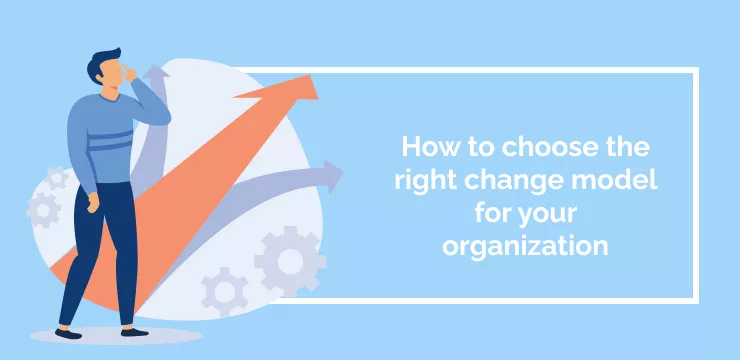
Deciding on the right organizational change model is vital for any successful transformation. After all, the model should guide decision-making and execution to achieve desired outcomes.
When choosing a change model, it’s important to identify current business objectives and the goals or ideal state that you want to achieve. These will provide parameters to help narrow down options. It can also be helpful to map out every aspect of a potential change process to understand better what needs to be done to achieve the desired result.
The next step is examining various existing change models and assessing how they could fit with your objectives and desired outcomes. This could include researching relevant literature and consulting with external experts in organizational change management.
Many different approaches exist, from waterfall methodologies such as Lewin’s Change Model to agile models like Scrum and even bespoke models tailored for individual organizations—all of which can bring advantages and disadvantages depending on specific circumstances.
It’s also paramount to consider factors such as cost/benefit analysis based on expected returns on investment; desired timeline and milestones; communication protocols; personnel requirements; risk assessments; proposed technology solutions; quantifiable measurements of success; anticipated challenges; and scalability concerns.
Ultimately, the chosen model must reflect an appropriate balance between readiness for changes versus the scope and complexity of the planned transformation process while ensuring that objectives are achieved within the existing resources available.
Finally, ensuring strong stakeholder engagement is key. It enables a clear understanding of roles, responsibilities, and expectations so everyone can work together to achieve successful outcomes from each stage of the planned transformation process.
By taking the time to understand organizational needs and choose an effective change model that meets them, organizations can increase their chances of successfully implementing organizational change programs that drive long-term value.
Seven key tips for delivering effective organizational change
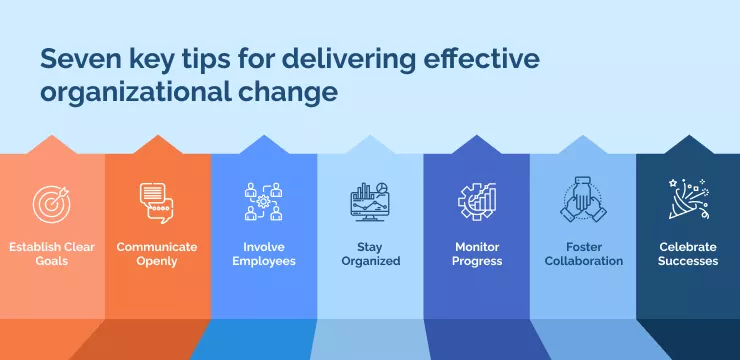
- Establish Clear Goals – When implementing organizational change, it is important to have a clear vision of what you want to achieve and why you are making the changes.
- Communicate Openly – During times of change, communication is key to ensuring everyone is on the same page and understands their roles and expectations.
- Involve Employees – Inviting input from employees when planning changes can help them feel engaged with the process. This could involve holding focus groups or brainstorming sessions to get an idea of how they would like things to look or what challenges they will face during implementation; this kind of feedback can then be used as a starting point for introducing effective solutions.
- Stay Organized – When delivering effective organizational change, tasks must be organized to be easy to track and prioritize; assigning individual responsibilities can also help keep everyone focused on their part in the challenging project ahead.
- Monitor Progress – Business leaders must regularly monitor progress during times of change to ensure everything runs smoothly and stays on a course toward the desired outcomes.
- Foster Collaboration – Collaboration between teams is essential to maximize efficiency during organizational change – this could include departments working together or encouraging cross-team communication between different project stakeholders.
- Celebrate Successes – Acknowledging individual contributions and thanking staff members for their hard work helps motivate everyone involved and reinforces team morale which is essential for successful organizational growth in the long run.
Choosing The Right Type of Change

Various types of organizational change can be implemented to meet the needs and goals of the organization.
Organization-wide change involves changes that impact the entire organization, such as introducing a new system or process. Transformational change requires a broader view and a more in-depth approach to creating long-term results. Personnel change includes staffing and training changes that help boost performance and productivity. Unplanned change is an unforeseen or unexpected change that occurs due to external factors, while Remedial change is used to correct mistakes or improve existing systems and processes.
Change management is a complex and multifaceted process. It is essential to differentiate between the various types of organizational change to implement the most effective strategy for your business. Change management skills are crucial to enabling successful change efforts in business processes, corporate culture, and the status quo.
However, change managers must understand the nuances of every kind of change and its potential implications on staff morale, motivation, and overall company performance. With an appropriate plan, businesses can ensure that personnel changes benefit their organization and support them in achieving their goals.
Organizations can create effective implementation strategies and manage transitions by understanding the different types of changes. With an effective plan, organizations can confidently embrace change and use it as an integral part of their growth process.
WalkMe Team
WalkMe spearheaded the Digital Adoption Platform (DAP) for associations to use the maximum capacity of their advanced resources. Utilizing man-made consciousness, AI, and context-oriented direction, WalkMe adds a powerful UI layer to raise the computerized proficiency, everything being equal.



